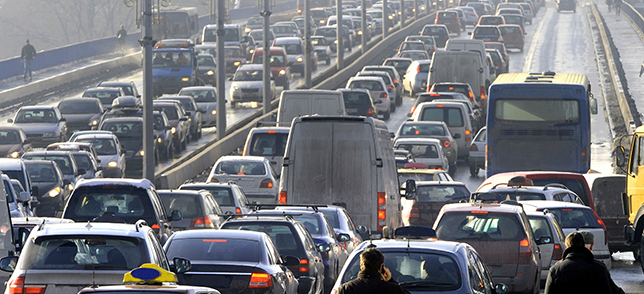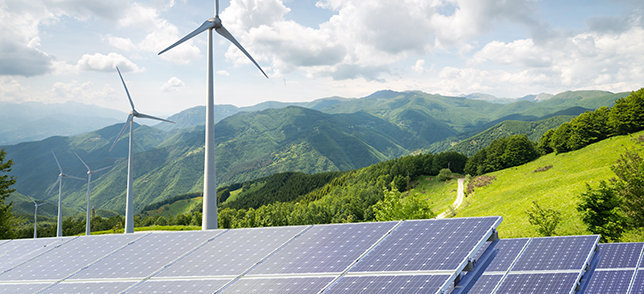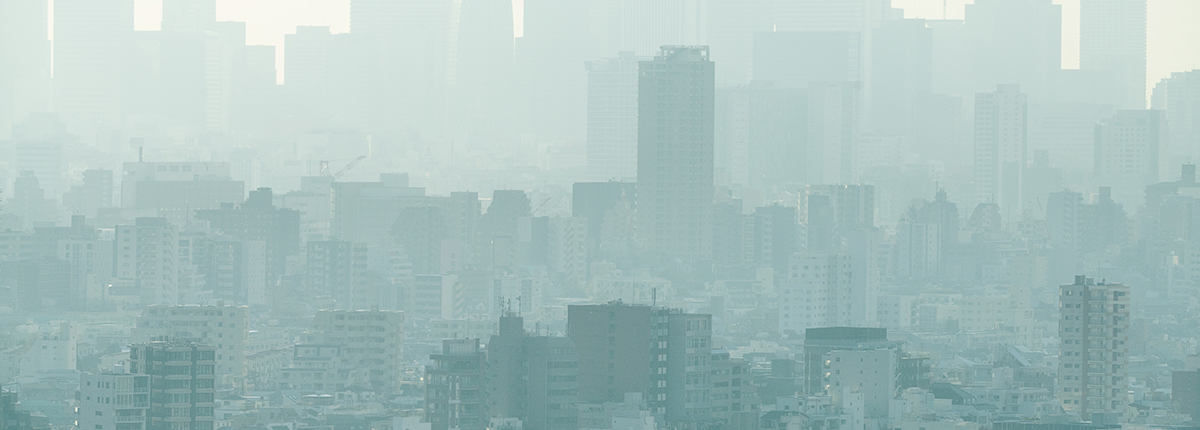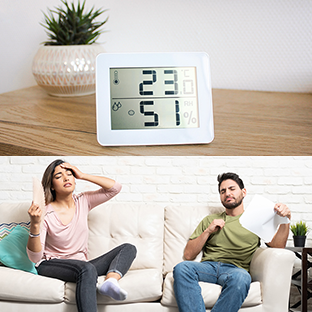What you need to know about PM2.5 pollution
What’s tiny can be so powerful. PM2.5 is smaller than a human hair. Despite its size, it can affect ecosystems as well as the climate. Government agencies even watch out for it, for the sake of public wellbeing. It floats around in the air, so small that you breathe it in – damaging your health. By the end of this post, you’ll know what PM2.5 is exactly, the risk it brings, and what you can do about it.
Table of Contents
- What is PM2.5?
- Is PM2.5 dangerous?
- How do you know if your area has bad PM2.5 levels?
- What is PM10? And what’s the difference?
- Where does PM2.5 come from?
○ Transportation
○ Power Plants
○ Burning wood
○ Smoking
○ Avoid diesel vehicles
○ Swap your wood burner
○ Quit smoking
○ Use renewable energy
○ nanoe™ X
What is PM2.5?
PM2.5 is a term that stands for fine particulate matter. These are tiny pollutant particles in the air that are 2 ½ microns or less wide. Thousands of the smallest of these particles could fit in the full stop at the end of this sentence.*1
Is PM2.5 dangerous?
Yes.It’s a pollutant that even contributes to the appearance of smog in cities.*2 High levels of smog in Pakistan and India can reduce visibility so much that they cause motor accidents.*3 And that’s not all. Living in an area with a lot of air pollution like PM2.5 is equivalent to smoking over 150 cigarettes a year.*4 In fact, just 24 hours of exposure to PM2.5 has been linked to increased hospital admissions, bronchitis, heart and lung problems, asthma attacks, and even premature death. These health effects have mostly been found in older adults and young children with pre-existing health conditions.*5 One study in 2015 even concluded that PM2.5 can cause lung cancer.*6 PM2.5 is also associated with milder conditions such as irritation of the eyes, nose, and throat, as well as sneezing, coughing and shortness of breath.*7 What’s more, there are links between increases in air pollution like PM2.5 and worsening symptoms in pollen allergy sufferers. The effects that outdoor air pollution has on the climate seems to be lengthening pollen seasons too – much to the dismay of people with allergies.*8
*2 https://www.ncbi.nlm.nih.gov/pmc/articles/PMC4740125/
*3 https://eu.usatoday.com/story/news/world/2017/11/05/smog-india-pakistan-air-pollution-causes-car-accidents-illness/833620001/
*4 https://www.bhf.org.uk/what-we-do/news-from-the-bhf/news-archive/2019/december/air-pollution-in-worst-hit-areas-asdeadly-as-smoking-over-150-cigarettes-each-year
*5 https://ww2.arb.ca.gov/resources/inhalable-particulate-matter-and-health
*6 https://ww2.arb.ca.gov/resources/inhalable-particulate-matter-and-health
*7 https://www.health.ny.gov/environmental/indoors/air/pmq_a.htm
*8 https://www.ncbi.nlm.nih.gov/pmc/articles/PMC8638356/
How do you know if your area has bad PM2.5 levels?
The clearest sign is when there’s smog, because it usually appears when there are high concentrations of PM2.5. Pay attention to your local government or weather forecast too, which may issue warnings when there are particularly high levels of this pollutant. You can also look online here, to find out how unhealthy levels are in your area. Lahore, Pakistan currently has an Air Quality Index (AQI) of 311 which is 52.1 times higher than the World Health Organisation’s (WHO) recommended limits – making it the unhealthiest in the world. Surprisingly, a large city like London has an AQI between 13 and 84, depending on the day.*9 That’s why it’s useful to check levels regularly so you can act accordingly. It’s important to keep in mind that even though the World Health Organisation has set recommended limits for air pollution, in reality there really is no completely safe level.*10 During 2021, London air pollution is estimated to have caused 8,500 deaths.*11
*9 https://www.iqair.com/earth
*10 https://www.blf.org.uk/taskforce/data-tracker/air-quality/pm25
*11 https://www.iqair.com/uk/england/london
What is PM10? And what’s the difference?
PM10 is a form of particulate pollution like PM2.5 but is bigger at 10 microns wide. Usually, PM10 has a different chemical composition to PM2.5, and comes from different emissions sources, though they do have some in common.*12
What causes PM2.5 pollution?
Transportation

It won’t surprise you to know that transportation emits PM2.5. But what will surprise you is the fact that it’s not just exhaust emissions which contribute, but non-exhaust emissions too. These are emissions that come from tyres, brakes and roads being worn down.*13 Non-exhaust emissions are still released by electric vehicles and are on the rise – expected to become the greatest contributor to transport emissions.*14 When it comes to exhaust emissions, petrol and diesel don’t just directly emit PM2.5, but also indirectly create it with the pollutant gases that they release which then cause chemical reactions in the atmosphere.*15
Power plants

Coal-fired power plants release PM2.5 due to their use of fossil fuels. They can increase PM2.5 levels in a city by 5%, and can even affect levels in areas as far as 250km away.*16 One study has shown the link between the closing-down of coal-fuelled power plants that emit PM2.5 as well as a reduction in deaths in the area, highlighting its relationship to our health.*17 But even natural gas power plants have also been known to emit PM2.5, just at lower levels.*18
Burning wood

Wood-burning emits more PM2.5 than cars. In Fairbanks, Alaska, a staggering 80% of PM2.5 emissions are from wood burning.*19 Considering how harmful PM2.5 can be, you might not want to light that cosy, warming woodfire this winter.
Smoking

Smoking tobacco releases PM2.5. And the effects of it don’t just stop when a cigarette is finished.
The harm from cigarette smoke continues to linger hours after. Second and thirdhand smoke can still do significant damage, most of which is caused by PM2.5.*20
*13 https://www.oecd.org/env/highlights-non-exhaust-particulate-emissions-from-road-transport.pdf
*14 https://www.oecd.org/env/highlights-non-exhaust-particulate-emissions-from-road-transport.pdf
*15 https://blog.ucsusa.org/dave-reichmuth/air-pollution-from-cars-trucks-and-buses-in-the-u-s-everyone-is-exposed-butthe-burdens-are-not-equally-shared/
*16 https://www.sciencedirect.com/science/article/abs/pii/S0048969720319203
*17 https://ehjournal.biomedcentral.com/articles/10.1186/s12940-020-00573-2
*18 http://www.cec.org/sites/default/napp/en/particulate-matter-emissions.php
*19 https://woodsmokepollution.org/wood-smoke-is-pm.html
*20 https://phys.org/news/2014-11-thirdhand-toxic-airborne-pollutants-linger.html
What you can do to reduce PM2.5 emissions in the environment
Avoid diesel vehicles
Diesel emits its own type of fine solid material which is known as Diesel Particulate Matter (DPM). Most of it is so small that it’s classed as PM2.5.*21 The best way to reduce PM2.5 from diesel vehicles, or any other kind of vehicle for that matter, is to drive less. If you can, try cycling or using public transport. It’s not only good for combating climate change but makes a difference to everyone’s health.
Quit smoking
If you’re a smoker, quitting will do wonders for your health – as well as for the health of the environment around you. By quitting, you’ll be reducing PM2.5 in your house as well as stopping PM2.5 that comes from thirdhand smoke.
Use renewable energy

Fossil fuels don’t just damage the beautiful planet that we call home, but they’re actually harming our health every day. Many health conditions can be caused by air pollution. How can you reduce the PM2.5 that comes from these sources? Stop using fossil fuels, if you can. Switching your home to renewable energy is better for your health, the planet, and is more affordable to use in the long term.*22
*21 https://ww2.arb.ca.gov/resources/overview-diesel-exhaust-and-health
*22 https://www.nhm.ac.uk/discover/news/2022/september/net-zero-cheaper-and-greener-than-continuing-use-fossilfuels.html
How to protect yourself from PM2.5
But what can you do on a personal level to protect yourself? You can use PM2.5 masks or N95 respirators when out and about, or an air purifier with an HEPA filter at home. But HEPA filters need to be regularly maintained to be effective.
nanoe™ X
For now, we have to accept that PM2.5 will be present wherever we go. But with nanoe™ X technology, you’ll be protected at home. nanoe™ X releases hydroxyl radicals which are naturally occurring unstable molecules. These molecules inhibit and break down the harmful substances found on PM2.5, including a variety of potential carcinogens. The result? Cleaner, fresher air at home that supports your wellbeing.








